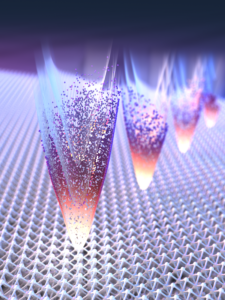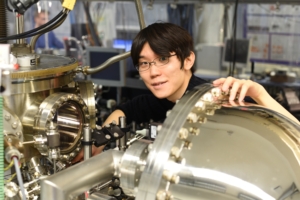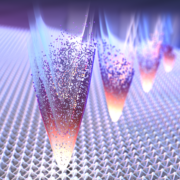When electrons dress up in light – Publication by B11 (Güdde/Höfer) in Nature
Suguru Ito, Jens Güdde and Ulrich Höfer, together with the group of Rupert Huber in Regensburg and physicists from across Europe, observed the ultrafast birth, rise, and collapse of a Floquet-Bloch band structure.

When electrons (spheres) are accelerated by strong light waves in the linearly dispersing surface state of Bi2Te3 (lowest cone), Floquet-Bloch replicas (higher cones) of the original band structure are formed. Videos of the band structure with sub-cycle time resolution reveal for the first time the formation dynamics (cones in the background). Photo: © Brad Baxley (parttowhole.com)
New material properties, at lightning speed and on demand – this vision moves a step closer thanks to the team’s findings. They used time- and angle-resolved photoemission spectroscopy to study the electrons in the Dirac surface state of the topological insulator Bi2Te3 that were previously shown to be effectively protected from scattering [Reimann et al., Nature 562, 396 (2018)]. By employing intense 25 THz light pulses, Ito and coworkers could drive these electrons back and forth periodically and watch how hybrid states between electrons and light, known as Floquet states or Floquet-Bloch bands, form at electric field strengths of ~ 1 MV/cm.
In Floquet states, the electrons don’t have just one fixed energy, but many energy states evenly spaced apart by the driving photon energies. The original eigenstate of the electron surrounds itself as if it was dressed with several envelopes of light. In terms of the dynamics of these exotic states, the team’s measurements went far beyond the limit of what could be achieved to date. They managed to take actual videos of the moving electrons with a time resolution better than a single oscillation cycle of the electromagnetic carrier wave of light. As a result, they made an unforeseen discovery, namely that Floquet-Bloch bands form already after a single optical cycle. This surprising finding paves the way to tailored quantum functionalities and ultrafast electronics. It is supported by theoretical modeling contributed by Michael Schüler of the Paul Scherrer Institute in Villigen, Switzerland, and Michael Sentef of the Max Planck Institute for Structure and Dynamics of Matter in Hamburg.

Dr. Suguru Ito, postdoc of SFB Project B11, conducts time-resolved ARPES measurements using a hemispherical electron analyzer. Photo: Jens Güdde
Having established the fundamental time limit for light-induced material engineering, the breakthrough discovery of Ito and coworkers could lead to a new age of physics, enabling the creation of new functionalities on demand. Following this avenue, Ulrich Höfer, Rupert Huber, Peter Puschnig (Graz), and Stefan Tautz (Jülich) were recently jointly awarded an ERC Synergy Grant from the European Research Council for their “Orbital Cinema” research project. This project aims to take slow-motion videos of electronic motion in quantum mechanical orbitals of adsorbed molecules and to push the research of SFB 1083 on organic/solid interfaces into the high-field regime.
Informational Material
– Joint Press release of the Universities of Marburg and Regensburg (in German).
– Press release of the Max Planck Institute for Structure and Dynamics of Matter in Hamburg (in English).
– Homepage of the Huber Group in Regensburg.
– News & Views Article by David Abergel (Chief Editor, Nature Physics).
Publication
S. Ito, M. Schüler, M. Meierhofer, S. Schlauderer, J. Freudenstein, J. Reimann, D. Afanasiev, K.A. Kokh, O.E. Tereshchenko, J. Güdde, M.A. Sentef, U. Höfer, R. Huber
Build-up and dephasing of Floquet–Bloch bands on subcycle timescales
Nature (2023) DOI:10.1038/s41586-023-05850-x
Contact
Prof. Dr. Ulrich Höfer
Philipps-Universität Marburg
SFB 1083 project B6, B11
Tel.: 06421 28-24215
EMAIL







